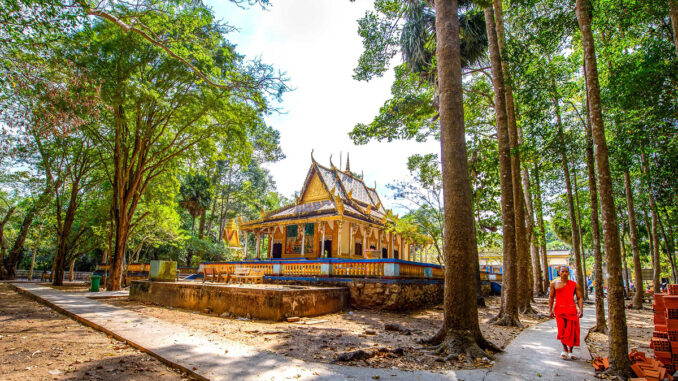
The temple is surrounded by typical Khmer architecture, such as star forests, ancient oils, and bat shelters.
Bat Pagoda (or Ma Clan Pagoda, Mahatup Pagoda) is located in Ward 3, Soc Trang City, associated with the architectural complex typical of the khmer people’s beliefs, recognized as a national art relic in 1999. It is a place for community activities and traditional Khmer festivals. Pictured is the main area of the pagoda, surrounded by forest of star trees, ancient oil.

Two foreign tourists pass by the front of Bat Pagoda’s main palace on February 16. Due to the impact of the epidemic, the number of visitors to the temple decreased compared to before.

Bat Pagoda’s main palace seen from behind. According to Lam Tu Linh, Deputy Abbot of the pagoda, it was formed in 1569, with simple architecture from bamboo and leaf roof. Through the restorations, the pagoda became more spacious as visitors see today.
In addition to the main hall, Bat Pagoda also has typical Khmer architecture such as Sala (ceremony hall), monks (monks’ resting place), black stupa and shrine for people to pray.

Bats living at the temple are mainly crow bats, horse bats. Adults have a wingspan of 1 – 1.5 m and a weight of 0.5 – 1 kg. At dusk, bats fly for food and return at about 3-4am the next morning.
Venerable Linh shared that a few decades ago, bats hundreds of thousands of bats were parked on branches but now the number has decreased greatly due to being hunted when they go for night. “The scene of bats flying in a wide sky every evening was left in memory,” he recalls.

Female tourists pray in front of the Statue of Buddha Of Song outside the main temple. The statue is made of 1.5 m high s cubes, dwelling on a tall lotus building. Around the statue decorated the patterns, characteristic motifs of the Khmer.

A monk lights incense in the peaceful space of the temple.

The monks read by the door frame. Above the columns are a floating statue depicting khmer fairy hands in the ceremony.

The monks of the pagoda carried sacks of rice that had just finished harvesting the winter-spring crop. The image of the monk harvesting rice or sub-building the pagoda is a feature of the Southern Khmer temples.

The monk is introducing a small model next to the ghe ngo displayed on the temple grounds. According to the local spiritual culture, each ghe ngo (about 22 to 27 m long) is the product of a temple, representing khmer hamlets.
Huynh Phuong/vnexpress
Photo: Dinh Cong Tam, Zhao Hon Vo
